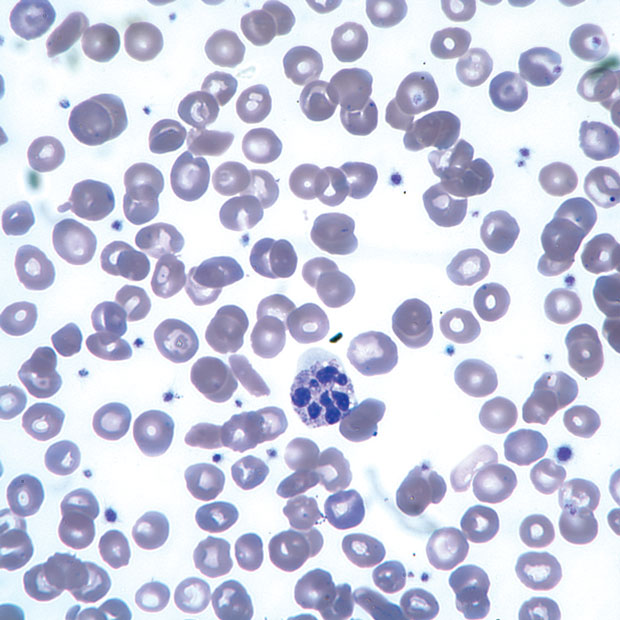MKSAP Quiz: Evaluation for fatigue
A 42-year-old woman is evaluated for several months of fatigue. She reports a normal diet and no gastrointestinal symptoms. Medical history is notable for hypothyroidism and vitiligo. Her only medication is levothyroxine.
On physical examination, vital signs are normal. She has several well-defined, hypopigmented macules symmetrically distributed on the extremities and trunk.
Laboratory studies:
| Hemoglobin | 8.8 g/dL (88 g/L) |
| Leukocyte count | 4000/μL (4 × 109/L) |
| Mean corpuscular volume | 117 fL |
| Platelet count | 160,000/μL (160 × 109/L) |
| Reticulocyte count | 1% of erythrocytes |

Peripheral blood smear is shown.
Which of the following is the most appropriate initial diagnostic test?
A. Homocysteine level
B. Methylmalonic acid level
C. Serum folate level
D. Serum vitamin B12 level
Answer and critique
The correct answer is D. Serum vitamin B12 level. This item is Question 5 in MKSAP 19's Hematology section.
The most appropriate diagnostic test for this patient is measuring the serum vitamin B12 level (Option D). Patients with vitamin B12 deficiency can present with weight loss, glossitis, and “lemon yellow” skin because of pallor and jaundice resulting from ineffective erythropoiesis. Vitamin B12 deficiency can cause neurologic symptoms, including loss of vibratory sense, loss of proprioception, spastic ataxia, and other dorsal column symptoms. Psychiatric symptoms (megaloblastic mania) can manifest as dementia, hallucinations, and frank psychosis. In patients with vitamin B12 deficiency, the peripheral blood smear shows oval macrocytes and hypersegmented neutrophils. Pancytopenia resulting from ineffective hematopoiesis can also be seen. Other laboratory findings are consistent with intramedullary hemolysis caused by ineffective erythropoiesis, including decreased haptoglobin and elevated lactate dehydrogenase levels and indirect hyperbilirubinemia. The reticulocyte count is low in patients with vitamin B12 deficiency. This patient most likely has vitamin B12 deficiency caused by pernicious anemia in which autoantibodies to intrinsic factor (IF) prevent the formation of vitamin B12-IF complexes, resulting in the impaired ability to absorb vitamin B12. Pernicious anemia can occur as an isolated finding or with other autoimmune conditions such as autoimmune thyroid disease and vitiligo as seen in this patient.
An elevated serum homocysteine level has a sensitivity and specificity of greater than 90% in diagnosing folate deficiency and is the preferred test when deficiency is suspected despite a normal serum folate level (Option A). Homocysteine levels are also elevated in patients with vitamin B12 deficiency, but vitamin B12 measurement is the preferred initial diagnostic test.
Serum vitamin B12 is approximately 95% sensitive in the diagnosis of vitamin B12 deficiency in symptomatic patients. Levels greater than 300 pg/mL (221 pmol/L) effectively exclude vitamin B12 deficiency; lower levels may not adequately represent tissue vitamin B12 levels. As such, an elevated concentration of methylmalonic acid is a more sensitive indicator of vitamin B12 deficiency (Option B). However, serum vitamin B12 measurement remains the preferred initial diagnostic test because of its sensitivity.
This patient consumes a normal diet and has no gastrointestinal symptoms. Supplemental folate has been added to grains in the U.S. for many years. As such, dietary folate deficiency is uncommon except in patients with malnutrition. Folate deficiency has no association with hypothyroidism or vitiligo. Measuring the serum folate level would be unnecessary (Option C).
Key Points
- Pernicious anemia, characterized by autoimmune gastritis and intrinsic factor deficiency, is a cause of cobalamin deficiency, which can be evaluated by measuring the serum cobalamin level.
- Pernicious anemia can occur as an isolated finding or with other autoimmune conditions such as autoimmune thyroid disease and vitiligo.




